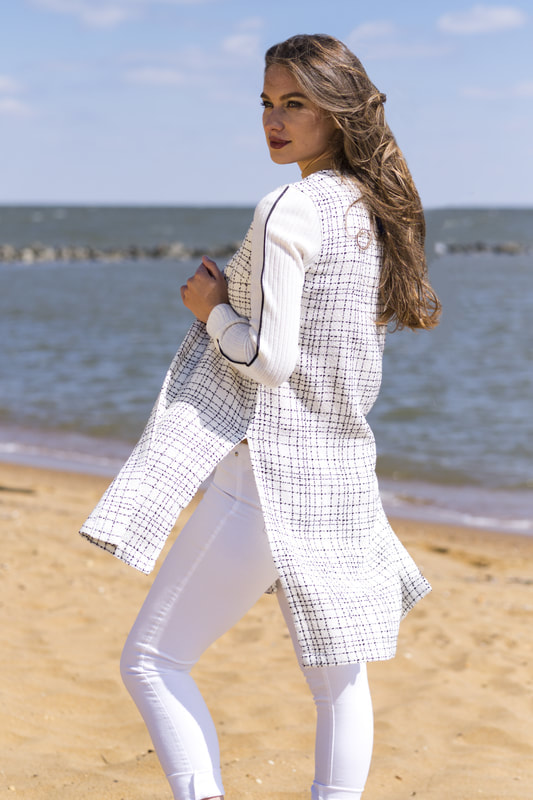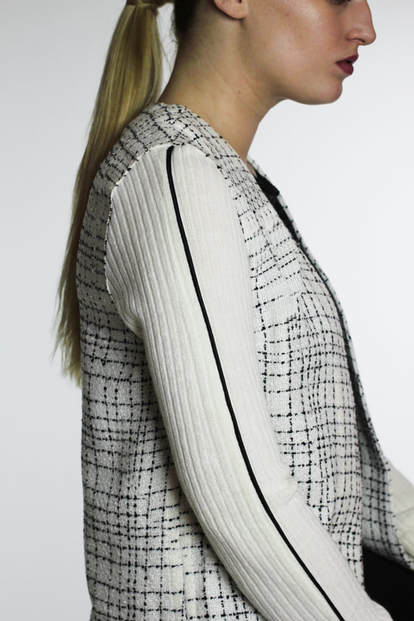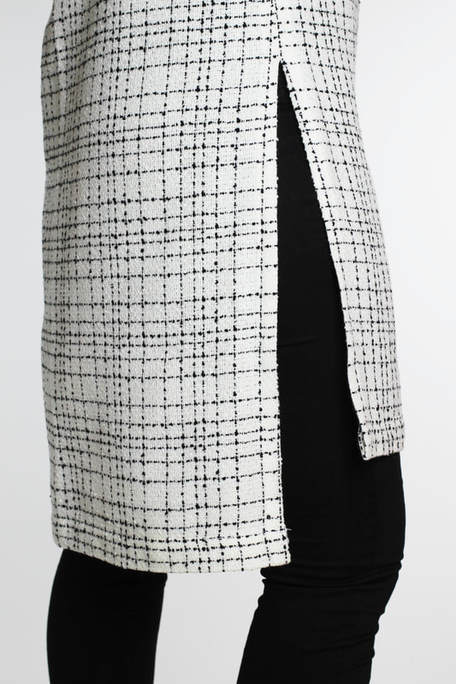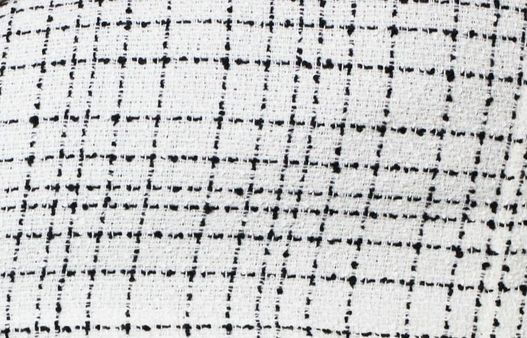|
A multi faceted clothing item is a goldmine in a woman's closet. The best return on investment is always a garment that can withstand wear in a range of styling combinations without compromising comfort. A well-balanced design that can effectively elevate or tone down an outfit is worth a lot of praise. The Alex Cardigan fits within the category of a versatile clothing item that easily transitions from work to play without jeopardizing comfort and aesthetics. At the office, it allows for maximum comfort while maintaining a professional, business appropriate look. After work, it pairs beautifully with a pair of jeans or even a little black dress. The beauty of the Alex Cardigan, and the reason it has become one of our favorites, is because it has the ability to effectively dress up a casual outfit and vise versa, dress down something that feels too formal. So what exactly is so special about the Alex Cardigan? Here are a few features that are bound to make you fall in love with it. An All Day Jacket-Cardigan Feel: A versatile styling option Some of the most valuable items in a woman's closet are those that can be styled in a variety of different ways and worn to a range of different occasions. The Alex Cardigan mixes casual with dressed up to bring forth a classic silhouette with dozens of styling options without compromising comfort. It is this comfort that allows for versatility in the first place. The Alex Cardigan makes our top list because it fits the bill to a T. Featuring sweater knit ribbed sleeves and a pair of waist-high side slits it allows for all day comfort without effecting the aesthetics of the style. It makes the perfect addition to any work outfit as a layering piece whether it is combined with a skirt, dress or pair of trousers. The black and white palette mixes well with any color, offering the classic black and white combination we've come to love so much. While the color combination is undeniably a classic, the unique linear design dresses up any outfit that needs a little kick without overwhelming it. Additionally, the function of versatility is to allow a clothing item to adapt to any circumstance or setting throughout the day. Specifically, its effortless ability to transition from day to night- wear it all day at work and throw it on with your evening outfit to either dress it up or down as desired. A Tailored Look With An Everyday Cardigan Feel The linear silhouette and a semi structured drape give the Alex Cardigan a tailored look yet still maintains its comfort throughout. Although it imitates a tailored spring jacket, it is not fully lined which allows it to feel more like an everyday cardigan further eliminating bulk and the hassle of dry cleaning. The Alex Cardigan features a structured, sturdy facing along its front opening emphasizing its tailored edge. The facing gives the cardigan's front opening an architectural style bringing forth its linear design. The cut of the silhouette itself mixes effortlessly with the black and white plaid print which is subtle yet still aesthetically unique. The acrylic boucle fabric eliminates the need for dry cleaning by offering easy care in a comfortable, wrinkle-free style. Since boucle is normally a suiting fabric, it adds additional tailoring flare to the style. The inclusion of the sweater knit sleeves however, brings forth the comfort and casual aspect of an everyday cardigan maintaining its linear design with a thick ribbed knit fabric. Additionally, the vertical black corded stripe going down the middle of each sleeve adds a flare of elegance to the more casual knit fabric balancing it with the rest of the black and white plaid print featured in the body of the Cardigan. What Makes it Special? The Ribbed Sweater Knit Sleeves The secret of the Alex Cardigan's comfort and versatility lies in the sweater knit sleeves. They soften the more tailored aspect brought forth by the black and white boucle fabric used in the body of the cardigan. The comfortable addition of the knit sleeves eliminates fit issues around the arms offering a comfortable, wearable option without compromising the aesthetic aspect of the style. Perhaps what makes them truly unique is the addition of black cording positioned vertically along the center of each sleeve. From an aesthetic perspective, the accented black stripe creates a smooth transition between the sleeve and the linear black and white print in the body of the cardigan allowing for a well balanced design. On a functional level, it is flattering and slenderizing elevating the style to match the more structured body of the cardigan. The sleeves offer just just the right amount of thickness featuring a thick ribbed knit structure. Both the sweater knit sleeves and boucle fabric have a similar fabric weight and hand which further balances the wearability of the cardigan. The Side Slits Along with the sweater knit sleeves, two side slits further emphasize comfort and versatility. They start at the waist and extend into a high-low hem. Design wise, they add versatility and ease of movement while their structured aspect further contribute to the tailored nature of the style. Side slits make a huge difference in a garment by elevating its comfort during wear as well allowing it to be paired with a range of styles from casual to more dressed up. While the side slits in the Alex Cardigan bring forth a more casual feel to the design, they are finishes to still maintain a semi-tailored look. In addition, combining slits with a suiting fabric like boucle is unique and allows for a more modern feel. The Linear High-Low Hem The linear high-low hem goes hand-in-hand with the slits to create a structured, linear style at the bottom of the cardigan. The front hem is higher than the back extending just enough to create a tunic-like length but not so much that it feels boxy. The side slits described above allow the bottom of the cardigan to feature some movement further emphasizing the hem's front-to-back length difference. Naturally, the back hem is extended to be longer, stopping at about mid-thigh. A longer back hem contributes to the comfort of the cardigan and allows for a more flattering, wearable silhouette. Although the high-low hem transition is subtle, it makes a huge difference in the design aspect of the cardigan both aesthetically and functionally. From an aesthetic point of view, it ties in all the the linear aspects of the cardigan's print and structure to create a visually pleasing design. From a functional perspective, it allows the Alex Cardigan to be versatile and flattering increasing comfort during wear. The Textured Black and White Print Needles to say, you can never go wrong with a classic black and white color combination. The black and white plaid-like print featured in the Alex Cardigan is quite subtle and very different from what we know as a classic plaid print. The black lines are not bold but aligned such as to create a unique yet wearable print. The thin black intersecting lines have depth and texture further emphasized by the textured quality of the boucle weaving itself. As mentioned above, the additional beauty of the fabric is its easy wear and care and it ability to maintain a wrinkle-free structure. For that reason the Alex Cardigan travels well and will maintain it's structural elements over long periods of wear. Styling Options: Jeans in any style or color. Pair it with a little a Little Black Dress. Work separates, from formal bottoms and tops to tailored work dresses. Casual combination of separates- Elevates the style of shorts and casual skirts and a range of casual top combinations.
1 Comment
8/28/2023 05:30:56 am
Great Post! Thanks for sharing this post with us. I really like this post and found very helpful.
Reply
Leave a Reply. |
The Blog:A journey into our design process, sewing tutorials, fashion tips, and all the inspiring people and things we love. Doina AlexeiDesigner by trade and dressmaker at heart. I spend most of my days obsessing over new fabrics and daydreaming new ideas. Sadie
Executive Assistant & Client Relations Manager Archives
November 2019
Categories
All
|
-
Sewing Tutorials
-
Basics
>
- Aligning Pattern Grainlines To Fabric
- Preparing Fabrics For Sewing
- Pinning Sewing Patterns To Fabric
- Placing Sewing Patterns On Fabric For Cutting
- Rotary Cutters or Fabric Scissors?
- Cutting The Sewing Patterns
- What Are Notches And How To Use Them In The Sewing Process
- Transferring Notches From Pattern To Fabric
- Transferring Seamlines to Fabric
- Staystitching
- Backstitching: A Complete Guide
- Hand Basting: A Complete Guide
- Sewing Continuous Bias Binding
- Darts >
-
Sewing Seams
>
- The Basics Of Seams And Seam Allowance
- How To Sew A Straight Seam
- Sewing Curved Seams
- Sewing Corner Seams
- Trimming And Grading Seam Excess
- Notching/Clipping Seam Allowance for Tension Release
- Sewing Topstitched Seams
- Sewing Corded Seams
- Sewing A Slot Seam
- Sewing A Gathered Seam
- Sewing Bias Seams
- Sewing Seams With Ease
- Sewing Seams With Crossing Seamlines
- Sewing Unlike Fabric Seams
- How To Iron Seams: Ironing Tools And Conventions
- Sewing With Knit Fabrics
- Understanding Stitch Length And Tension
- Sewing Unique Fabric Seams
-
Seam Finishes
>
- Seam Finishing Techniques - Overview
- Applying A Pinked Seam Finish
- Applying A Bias Bound Seam Finish
- Serging And Zigzag Seam Finishes
- Sewing A Self-Bound Seam Finish
- Sewing A French Seam Finish
- Sewing A Hong Kong Seam Finish
- Sewing A Mock French Seam Finish
- Sewing A Turned-and-Stitched Seam Finish
- Sewing Overcast Hand-Applied Seam Finishes
- Sewing A Flat Felled Seam
- Sewing A Hairline Seam Finish
-
Hem Finishes
>
- Garment Hem Finishes: Overview
- Sewing A Double Fold Hem Finish
- Sewing A Single Fold Hem Finish
- Sewing Bound Hem Finishes
- Sewing An Exposed Double Layer Bound Hem
- Sewing A Folded-Up Bound Hem with Pre-folded Binding
- Sewing A Hong Kong Hem Finish
- Sewing A Band Hem Finish
- Sewing A Bias Faced Hem Finish
- Sewing A Twill Tape Hem Finish
- Sewing A Rolled Hem Finish
- Sewing A Shaped Hem Facing
- Using Fusible Hem Tape And Webbing
- Finishing A Lace Fabric Hem
- Finishing A Leather Hem
- Sewing Faced Hem Corners
- How To Finish Lining At The Hem
- Finishing Fabric Corners by Mitering >
- Interfacing A Hemline: Lined And Unlined Examples
-
Sewing Pockets
>
- Curved Patch Pocket With Flap
- Unlined Square Patch Pockets
- Lined Patch Pockets: Two Ways
- Extension On-Seam Pockets
- Separate On-Seam Pocket
- Front Hip Pockets
- Bound Double Welt Pocket
- Double Welt Pocket With Flap
- Self-Welt Pocket (Using Single Fabric Layer)
- Slanted Welt Pocket (Hand-Stitched)
- Faced Slash Pockets: Overview >
-
Sewing Zippers
>
- Sewing Zippers: General Information
- Sewing A Centered Zipper
- Sewing A Lapped Zipper
- Sewing An Invisible Zipper
- Sewing A Fly Front Zipper
- Sewing A Closed-End Exposed Zipper (No Seam)
- Sewing An Exposed Separating Zipper
- Sewing Hand Stitched Zipper Applications
- Sewing A Zipper Underlay
- Sewing A Placket-Enclosed Separating Zipper
- Sleeveless Finishes >
-
Neckline Finishes
>
- Sewing A Neck Shaped Facing
- Sewing An All-In-One Neck Facing
- Neck And Garment Opening Combination Facings >
- Sewing A Bias Faced Neckline Finish
- Sewing A Band Neckline Finish
- Bound Neckline Finishes: Overview >
- Sewing A Semi-Stretch Strip Band Neckline
- Ribbed Neck Band And Classic Turtleneck
- Decorative Neckline Finishes >
- Finishing Facing Edges >
-
Extras
>
- A Complete Guide on Interfacing
- Sewing Bound Spaghetti Straps
- Sewing Spaghetti Straps To A Faced Neckline
- Sewing Ruffles: Overview
- Patterning And Sewing A Circle Ruffle
- Sewing A Gathered Heading Ruffle
- Sewing Double Layer Gathered Ruffles
- Sewing A Gathered Ruffle Into A Seam
- Sewing A Gathered Ruffle To A Fabric Edge
- Sewing A Fabric Surface Slit
- Sewing A Slit Seam
- Hand-Applied Straight Stitches
- Hand-Applied Blind Stitches
- Hand-Applied Overedge Stitches
- Hand-Applied Tack Stitches
- Hand-Applied Decorative Stitches
-
Basics
>
- Custom Bridal
- Custom Apparel
- About
- Blog
Services |
Company |
|








 RSS Feed
RSS Feed

